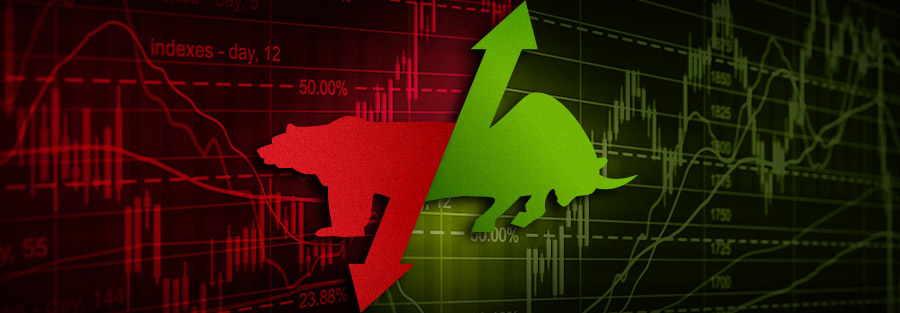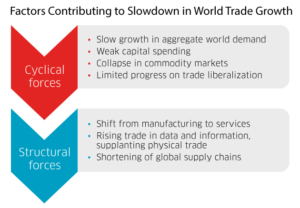IHS Outlook: Global Supply Chain Trends and Threats
Global trade and the many supply chains that support it are continually subject to shifts in economic conditions, geopolitical regimes, and politics. Recently, two major trends have emerged that have the potential to disrupt supply chains and global economic growth: economic slowdown of emerging markets and renewed threat to globalization.
Emerging Markets
A number of emerging markets have experienced a rapid deterioration in their economic performance over the last few years. China is still maintaining relatively strong growth— real GDP (gross domestic product) growth was 6.9 percent in 2015, and 2016 it is projected to be 6.7 percent before slowing further to a 6.4 percent rate for 2017. China is in the midst of a slow transformation from a global production powerhouse to a more middle-class-dominated, service-oriented economy. Evidence of this transition is the partial displacement of China’s mining, heavy manufacturing, and utilities by services and light manufacturing.
“Two major trends have emerged that have the potential to disrupt supply chains and global economic growth: economic slowdown of emerging markets and renewed threat to
globalization.”
Brazil and Russia are starting to inch out of their recessions. Russia is closely tied to the ups and downs of oil markets and has also been impacted by Western sanctions. Some relief is on the way for oil and commodity producing countries since commodity prices have for the most part reached bottom and are starting to rise, albeit gradually. Brazil’s real GDP growth for 2015 was negative 3.8 percent and is likely to clock in a negative 3.6 percent rate for 2016, before finally entering positive growth in 2017. Brazil slipped into recession in the first half of 2014 due to declining investment, the end of the commodity super cycle, and a slowdown in private sector consumption.
India’s overall growth has stood up over the past few years and has been stronger than China’s – however, India’s annual GDP per capita is about $1,500, compared to $54,000 in the U.S. and $6,800 in China. India, therefore, is likely to experience what we call the “per capita problem,” in which any slowdown in an emerging market economy with low income or low GDP per capita feels like a recession. Unless a country has a sufficient level of per capita income before growth rates begin slowing to levels approaching those of developed economies, declining growth will hinder the standard of living and rattle even a confident consumer. This is especially true if coupled with relatively strong population growth, which makes it even more difficult for the struggling economy to absorb the new entrants into the labor market. There are significant political and socioeconomic issues and tensions that arise as the ascending “middle” class gets comfortable with a certain standard of living and expectations. The street demonstrations in Brazil and Turkey in the first half of 2013 are two prime examples.
The restraints on emerging market economic growth looking ahead include excess capacity after a strong investment boom, slowdown in world trade, low commodity prices, capital flight, downward pressure on local currencies and debt accumulation. However, several turnaround conditions are in the works, including recovery in commodity and equity markets, rising domestic demand and market and fiscal reforms implemented to improve efficiency.
“Globalization has become the scapegoat for many of the problems in advanced economies, including job losses, poor wage growth and increasing income inequality.”
Globalization Under Threat
Globalization has become the scapegoat for many of the problems in advanced economies, including job losses, poor wage growth and increasing income inequality. Brexit and the outcome of the 2016 U.S. presidential election are two major events that point to further weakening of support for globalization in the advanced economies.
The support for globalization is often in sync with the performance of the economy. During the Great Depression, the United States imposed various tariffs only to be matched by tariffs from other countries. All of this had the impact of making a bad situation even worse. Trade agreements such as NAFTA (North American Free-Trade Agreement) faced critical opposition – for example, 1992 presidential candidate Ross Perot’s famous quip that if NAFTA was enacted “there will be a giant sucking sound going south.” During the late 1990s and early 2000s, there were massive anti-globalization demonstrations at World Trade Organization, International Monetary Fund, and World Bank meetings. More recently, U.S. President-elect Donald Trump voiced opposition to the proposed Trans-Pacific Partnership (TPP). Deep resentment about the number of immigrants coming into the United Kingdom was a powerful driving force behind the vote to leave the European Union. Similarly, both the U.S. Democratic and Republican parties (and especially their presidential candidates) have turned their backs on free trade and immigration.
Brexit and political uncertainty in Europe have clouded Europe’s economic outlook. Italy’s Prime Minister Matteo Renzi resigned in early December over a referendum outcome concerning parliamentary restructuring. The result of the U.S. election has emboldened right-wing populist parties in Europe. There are elections scheduled for 2017 in the Netherlands (March), France (April/May), and Germany (September).
“The global economic impacts of the incoming U.S. presidential administration depend on whether ‘protectionist populism’ or ‘pro-growth populism’ is the dominant theme.”
The impacts of technology and globalization are often intertwined. Both destroy some jobs and create many more. Unfortunately, the costs tend to be disproportionately borne by workers with lower levels of education. The beneficiaries include high-skilled workers and consumers (via lower prices). The pain is concentrated and visible, while the benefits are widespread. Politically motivated attempts to help those hurt by globalization, via higher tariffs or other forms of protectionism, will raise prices and hurt all consumers, especially poor and middle-class families—not to mention damaging the competitiveness of companies that import raw materials and components from other countries. Nevertheless, a lot more needs to be done to assist workers hurt by globalization and technology in order to diminish the anxiety and anger of those suffering economically.
The global economic impacts of the incoming U.S. presidential administration depend on whether “protectionist populism” or “pro-growth populism” is the dominant theme. Even more so than Brexit, the election of Donald Trump as the next president of the United States has the potential of upsetting the established global supply chains and networks. If protectionist policies are pursued, growth in global trade and real GDP will likely be slower. If pragmatic, pro-growth policies are pursued, then overall economic growth will be higher — an outcome that will benefit most economies around the world.

